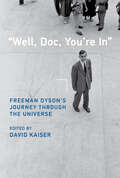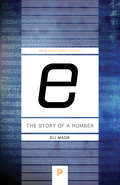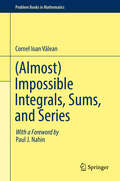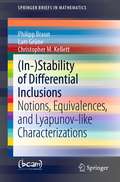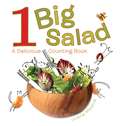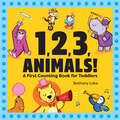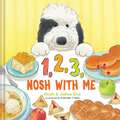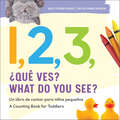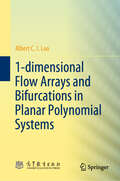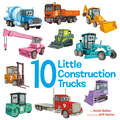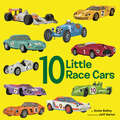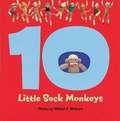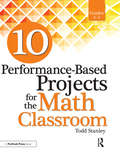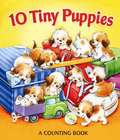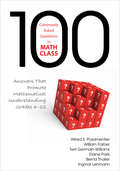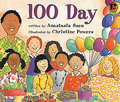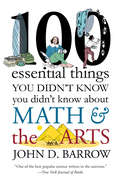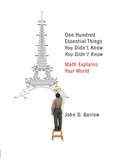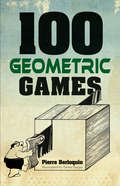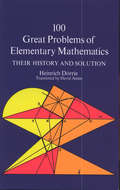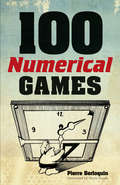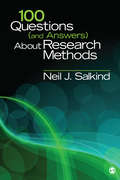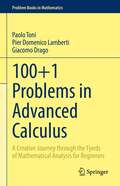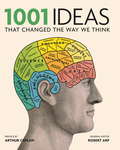- Table View
- List View
"Well, Doc, You're In": Freeman Dyson’s Journey through the Universe
by Edited by David KaiserThe life and work of Freeman Dyson—renowned scientist, visionary, and iconoclast—and his particular way of thinking about deep questions.Freeman Dyson (1923–2020)—renowned scientist, visionary, and iconoclast—helped invent modern physics. Not bound by disciplinary divisions, he went on to explore foundational topics in mathematics, astrophysics, and the origin of life. General readers were introduced to Dyson&’s roving mind and heterodox approach in his 1979 book Disturbing the Universe, a poignant autobiographical reflection on life and science. &“Well, Doc, You&’re In&” (the title quotes Richard Feynman&’s remark to Dyson at a physics conference) offers a fresh examination of Dyson&’s life and work, exploring his particular way of thinking about deep questions that range from the nature of matter to the ultimate fate of the universe. The chapters—written by leading scientists, historians, and science journalists, including some of Dyson&’s colleagues—trace Dyson&’s formative years, his budding interests and curiosities, and his wide-ranging work across the natural sciences, technology, and public policy. They describe Dyson&’s innovations at the intersection of quantum theory and relativity, his novel nuclear reactor design (and his never-realized idea of a spacecraft powered by nuclear weapons), his years at the Institute for Advanced Study, and his foray into cosmology. In the coda, Dyson&’s daughter Esther reflects on growing up in the Dyson household. &“Well, Doc, You&’re In&” assesses Dyson&’s successes, blind spots, and influence, assembling a portrait of a scientist&’s outsized legacy. ContributorsJeremy Bernstein, Robbert Dijkgraaf, Esther Dyson, George Dyson, Ann Finkbeiner, Amanda Gefter, Ashutosh Jogalekar, David Kaiser, Caleb Scharf, William Thomas
"e": The Story of a Number
by Eli MaorThe interest earned on a bank account, the arrangement of seeds in a sunflower, and the shape of the Gateway Arch in St. Louis are all intimately connected with the mysterious number e. In this informal and engaging history, Eli Maor portrays the curious characters and the elegant mathematics that lie behind the number. Designed for a reader with only a modest mathematical background, this biography brings out the central importance of e to mathematics and illuminates a golden era in the age of science.
**Missing** (Problem Books in Mathematics)
by Cornel Ioan VăleanThis book contains a multitude of challenging problems and solutions that are not commonly found in classical textbooks. One goal of the book is to present these fascinating mathematical problems in a new and engaging way and illustrate the connections between integrals, sums, and series, many of which involve zeta functions, harmonic series, polylogarithms, and various other special functions and constants. Throughout the book, the reader will find both classical and new problems, with numerous original problems and solutions coming from the personal research of the author. Where classical problems are concerned, such as those given in Olympiads or proposed by famous mathematicians like Ramanujan, the author has come up with new, surprising or unconventional ways of obtaining the desired results. The book begins with a lively foreword by renowned author Paul Nahin and is accessible to those with a good knowledge of calculus from undergraduate students to researchers, and will appeal to all mathematical puzzlers who love a good integral or series.
**Missing**: Notions, Equivalences, and Lyapunov-like Characterizations (SpringerBriefs in Mathematics)
by Lars Grüne Philipp Braun Christopher M. KellettLyapunov methods have been and are still one of the main tools to analyze the stability properties of dynamical systems. In this monograph, Lyapunov results characterizing the stability and stability of the origin of differential inclusions are reviewed. To characterize instability and destabilizability, Lyapunov-like functions, called Chetaev and control Chetaev functions in the monograph, are introduced. Based on their definition and by mirroring existing results on stability, analogue results for instability are derived. Moreover, by looking at the dynamics of a differential inclusion in backward time, similarities and differences between stability of the origin in forward time and instability in backward time, and vice versa, are discussed. Similarly, the invariance of the stability and instability properties of the equilibria of differential equations with respect to scaling are summarized. As a final result, ideas combining control Lyapunov and control Chetaev functions to simultaneously guarantee stability, i.e., convergence, and instability, i.e., avoidance, are outlined. The work is addressed at researchers working in control as well as graduate students in control engineering and applied mathematics.
1 Big Salad: A Delicious Counting Book
by Juana Medina<p>Juana Medina's ingenious illustrations nearly pop off the page in her new counting book, ONE BIG SALAD. One avocado deer saunters across the spread, two radish mice scurry by, until finally ten clementine kitties prance onto the scene - all of the ingredients in one big salad! <p>Medina's previous book with Viking, SMICK!, introduced her to the children's book world, and now she's bringing her fresh and innovative take on the concept book form.</p>
1 Mississippi 2 Mississippi: A Mississippi Number Book
by Michael Shoulders1 Mississippi, 2 Mississippi is a fitting follow-up to its companion state alphabet book. This fun, colorful, and superbly informative book teaches children about numbers using recognizable places, events, and facts from their respective states. Numbers throughout the books are explained with simple rhyme for younger children and are accompanied by detailed expository text for older learners.
1, 2, 3, Animals!: A First Counting Book for Toddlers
by Bethany LakeGet ready to count cute animals—number fun for ages 0 to 3 When it's time to teach your toddler to count, the host of friendly animals, visualization techniques, and catchy rhymes in this book makes it easy. 1, 2, 3 Animals! is a standout among counting books for toddlers and will give your child the building blocks for math success through a fun, engaging story and adorable drawings. A step above other counting books for toddlers, this one has it all. Watch your young one develop a love for numbers as the animals put on their show! Each page offers multiple opportunities to count each number, and do it in the correct order as they make it to the big 1-0. Go beyond other counting books for toddlers: Forward and backward—The pages are in sequential order from 1 to 10, with the last few pages instructing them how to count down from 10 to 1. Rhyming narrative—The simple and fun prompts are part of a captivating story that will keep toddlers engaged and wanting to learn more. Striking pictures—Within the world of counting books for toddlers, this one has vivid illustrations that will hold your kid's interest until they're counting a master. When it comes to counting books for toddlers, 1, 2, 3 Animals! has what your little one needs to learn in an easy and fun way.
1, 2, 3, Nosh With Me
by Micah Siva Joshua SivaCulture and education are deliciously interwoven in this playful exploration of Jewish delicacies for young readers."The perfect book to jumpstart children's interest in these traditional foods as they reinforce their counting skills." —Faith Kramer, best-selling author of 52 Shabbats: Friday Night Dinners Inspired by a Global Jewish Kitchen Buckwheat the Sheepadoodle needs help preparing his holiday meal! One by one, young readers are guided through ten delicious foods of Jewish holidays, family gatherings, and Shabbat dinners. Both appetizing and educational, 1, 2, 3 Nosh With Me helps young children learn about basic numbers as well as traditional Jewish cuisine. And if all the counting makes your little one hungry, use the bonus recipe for Simple Challah included to make your own tasty loaf! MORE PRAISE FOR 1, 2, 3 NOSH WITH ME &“From the tactile cover to the challah recipe, and all the fun foods in between, my family and I loved this book!&” —Rachel Teichman, author of B is for Bagel and D is for Donut &“The illustrations opened up conversations about some of our favorite Jewish foods and traditions and my daughters had so much fun counting along with each page!&” —Ariel Stein, founder of Ariel Loves and Jewish educator
1, 2, 3, What Do You See? English-Spanish Bilingual: A Counting Book for Toddlers
by Jocelyn M. WoodTeach toddlers to count from 1 to 20 in English and Spanish!Watch your little one learn to count in two languages with this photo-filled book of happy puppies, juicy berries, and bouncy balls! Each page reveals a new number and a new collection of bright and colorful objects, making it easy for toddlers to start counting in English and Spanish. Fundamental skills—Prep your toddler for preschool as they practice identifying simple objects and counting from 1 to 20. Education in two languages—Build the foundation for a lifetime of bilingual learning by introducing your child to key vocabulary at an early age. Make learning fun—Bring learning to life for your child with vibrant illustrations and familiar words and items. Give your little learner a head start with this colorful counting book for toddlers.
1-dimensional Flow Arrays and Bifurcations in Planar Polynomial Systems
by Albert C. LuoThis book introduces to 1-dimensional flow arrays and bifurcations in planar polynomial systems. The 1-dimensional source, sink and saddle flows are discussed, as well as the 1-dimensional parabola and inflection flows. The singular source, sink and saddle flows are the appearing and switching bifurcations for simple sink and source flow arrays and for lower-order singular source, sink and saddle flow arrays. The singular parabola and inflection flows are the appearing and switching bifurcations for simple parabola arrays and also for lower-order singular parabola and inflection flow arrays. The infinite-equilibriums in single-variable polynomial systems are also discussed, which are the appearing and switching bifurcations of hybrid arrays of source, sink, and saddle flows with parabola and inflections. This book helps readers understand the global dynamics of planar polynomial systems and the Hilbert sixteen problem.
10 Little Construction Trucks (10 Little Vehicles)
by Annie BaileyFans of cars and trucks can count down from ten to one as they follow ten construction vehicles on a busy workday. This sturdy board book is perfect for the youngest readers!Ten little construction trucks excited for the day. They can&’t wait to get to work, but something&’s in their way!On each page of this exciting board book, young readers can count down construction vehicles from ten to one. Along the way, they'll learn about different machines on a construction site, such as bulldozers, rollers, forklifts, and concrete mixers. With action on every page, this is the perfect book to read aloud with your little vehicle fan.Also available:10 Little Tractors10 Little Excavators10 Little Race Cars
10 Little Race Cars (10 Little Vehicles)
by Annie BaileyFans of cars and trucks can count down from ten to one as they follow ten classic race cars zooming around the track. This sturdy board book is perfect for the youngest readers!Ten little race cars ready to compete.Time for some fun—Brummmm! Crowd is on their feet.It's the car race of the century! On each page of this action-packed board book, young readers can count down race cars from ten to one. Along the way, motorsport fans will spot cars inspired by some of the legends of the history of racing, including the Porsche 917, Lancia Stratos, McLaren MP4/4, and Bugatti Type 35. With noisy words on every page, this is the perfect book to read aloud with your little race car fan.Also available:10 Little Tractors10 Little Excavators10 Little Construction Trucks
10 Little Sock Monkeys
by Harriet ZiefertTen little monkeys are swinging on a bar. Two by two, these creatures drop away, while all the rest continue to play.
10 Performance-Based Projects for the Math Classroom: Grades 3-5
by Todd StanleyEach book in the 10 Performance-Based Projects series provides 10 ready-made projects designed to help students achieve higher levels of thinking and develop 21st-century skills. Projects are aligned to the Common Core State Standards, allowing students to explore and be creative as well as gain enduring understanding. Each project represents a type of performance assessment, including portfolios, oral presentations, research papers, and exhibitions. Included for each project is a suggested calendar to allow teacher scheduling, mini-lessons that allow students to build capacity and gain understanding, as well as multiple rubrics to objectively assess student performance. The lessons are presented in an easy-to-follow format, enabling teachers to implement projects immediately.Grades 3-5
100 Commonly Asked Questions in Math Class: Answers That Promote Mathematical Understanding, Grades 6-12
by Alfred S. Posamentier Bernd Thaller Terri L. Germain-Williams William L. Farber Elaine S. Paris Ingmar H. Lehmann100 ways to get students hooked on math! That one question got you stumped? Or maybe you have the answer, but it’s not all that compelling. Al Posamentier and his coauthors to the rescue with this handy reference containing fun answers to students’100 most frequently asked math questions. Even if you already have the answers, Al’s explanations are certain to keep kids hooked. The big benefits? You’ll discover high-interest ways to Teach to the Common Core’s math content standards Promote inquiry and process in mathematical thinking Build procedural skills and conceptual understanding Encourage flexibility in problem solving Emphasize efficient test-taking strategies
100 Day
by Anastasia Suen Christine Powers<p>A class of kindergarten children celebrate the 100th day of school. <p>Guided Reading: C; Interest Level: Grades 1 - 1; Reading Level: Grades 1 - 1; Themes: Comparing/Classifying/Measuring, Counting Money/Everyday Math, Classroom Activities, Multi-ethnic interest, Games/Toys, Education, Cultural Diversity, Childhood Experiences and Memories, Beginning Concepts, Realistic Fiction, Collaboration
100 Essential Things You Didn't Know You Didn't Know about Math and the Arts
by John D. BarrowA fascinating exploration of math's connection to the arts. At first glance, the worlds of math and the arts might not seem like comfortable neighbors. But as mathematician John D. Barrow points out, they have a strong and natural affinity--after all, math is the study of all patterns, and the world of the arts is rich with pattern. Barrow whisks us through 100 thought-provoking and often whimsical intersections between math and many arts, from the golden ratios of Mondrian's rectangles and the curious fractal-like nature of Pollock's drip paintings to ballerinas' gravity-defying leaps and the next generation of monkeys on typewriters tackling Shakespeare. For those of us with our feet planted more firmly on the ground, Barrow also wields everyday equations to reveal how many guards are needed in an art gallery or where you should stand to look at sculptures. From music and drama to literature and the visual arts, Barrow's witty and accessible observations are sure to spark the imaginations of math nerds and art aficionados alike.
100 Essential Things You Didn't Know You Didn't Know: Math Explains Your World
by John D. Barrow"Where else does math become a romp, full of entertaining tricks and turns?"--Bryce Christensen, Booklist Have you ever considered why you always get stuck in the longest line? Why two's company but three's a crowd? Or why there are six degrees of separation instead of seven? In this hugely informative and endlessly entertaining book, John D. Barrow takes the most baffling of everyday phenomena and--with simple math, lucid explanations, and illustrations--explains why they work the way they do. His witty, crystal-clear answers shed light on the dark and shadowy corners of the physical world we all think we understand so well.
100 Geometric Games
by Martin Gardner Pierre Berloquin Denis DugasThere are three loops in a tangle of rope. How many are independent, and how many are interlocked?Two knights stand on a chessboard. How many other knights must you add so that each square is occupied or threatened by a knight?Among six seemingly identical drawings of mandalas, each rotated by multiples of 60 degrees, one is different. Which is it, and why?Challenge yourself with these mind-benders, brainteasers, and puzzles. Each of them has been carefully selected so that none will be too tough for anyone without a math background - but they're not too easy. Some are original, and all are clearly and accurately answered at the back of the book.
100 Great Problems of Elementary Mathematics
by Heinrich Dörrie"The collection, drawn from arithmetic, algebra, pure and algebraic geometry and astronomy, is extraordinarily interesting and attractive." -- Mathematical GazetteThis uncommonly interesting volume covers 100 of the most famous historical problems of elementary mathematics. Not only does the book bear witness to the extraordinary ingenuity of some of the greatest mathematical minds of history -- Archimedes, Isaac Newton, Leonhard Euler, Augustin Cauchy, Pierre Fermat, Carl Friedrich Gauss, Gaspard Monge, Jakob Steiner, and many others -- but it provides rare insight and inspiration to any reader, from high school math student to professional mathematician. This is indeed an unusual and uniquely valuable book.The one hundred problems are presented in six categories: 26 arithmetical problems, 15 planimetric problems, 25 classic problems concerning conic sections and cycloids, 10 stereometric problems, 12 nautical and astronomical problems, and 12 maxima and minima problems. In addition to defining the problems and giving full solutions and proofs, the author recounts their origins and history and discusses personalities associated with them. Often he gives not the original solution, but one or two simpler or more interesting demonstrations. In only two or three instances does the solution assume anything more than a knowledge of theorems of elementary mathematics; hence, this is a book with an extremely wide appeal.Some of the most celebrated and intriguing items are: Archimedes' "Problema Bovinum," Euler's problem of polygon division, Omar Khayyam's binomial expansion, the Euler number, Newton's exponential series, the sine and cosine series, Mercator's logarithmic series, the Fermat-Euler prime number theorem, the Feuerbach circle, the tangency problem of Apollonius, Archimedes' determination of pi, Pascal's hexagon theorem, Desargues' involution theorem, the five regular solids, the Mercator projection, the Kepler equation, determination of the position of a ship at sea, Lambert's comet problem, and Steiner's ellipse, circle, and sphere problems.This translation, prepared especially for Dover by David Antin, brings Dörrie's "Triumph der Mathematik" to the English-language audience for the first time.
100 Numerical Games
by Martin Gardner Pierre Berloquin Denis DugasFollow the hour hand and minute hand of a clock for 24 hours. How many times do they form a right angle?Timothy's house has several rooms, each of which has an even number of doors, including doors that lead outside. Is the number of outside doors even or odd?Stimulating and delightful, this collection of puzzles features original and classic brainteasers. The author, a puzzle columnist for Le Monde, specially selected these mind-benders for the widest possible audience, ensuring that they're neither too hard for those without a math background nor too easy for the mathematically adept. All puzzles are clearly stated and accurately answered at the back of the book - and they're great fun to consider, whether you crack them or not. Includes a Foreword by Martin Gardner.
100 Questions (SAGE 100 Questions and Answers)
by Neil J. Salkind"How do I create a good research hypothesis?""How do I know when my literature review is finished?""What is the difference between a sample and a population?""What is power and why is it important?"In an increasingly data-driven world, it is more important than ever for students as well as professionals to better understand the process of research. This invaluable guide answers the essential questions that students ask about research methods in a concise and accessible way.
100+1 Problems in Advanced Calculus: A Creative Journey through the Fjords of Mathematical Analysis for Beginners (Problem Books in Mathematics)
by Pier Domenico Lamberti Paolo Toni Giacomo DragoThis book convenes a collection of carefully selected problems in mathematical analysis, crafted to achieve maximum synergy between analytic geometry and algebra and favoring mathematical creativity in contrast to mere repetitive techniques. With eight chapters, this work guides the student through the basic principles of the subject, with a level of complexity that requires good use of imagination.In this work, all the fundamental concepts seen in a first-year Calculus course are covered. Problems touch on topics like inequalities, elementary point-set topology, limits of real-valued functions, differentiation, classical theorems of differential calculus (Rolle, Lagrange, Cauchy, and l’Hospital), graphs of functions, and Riemann integrals and antiderivatives. Every chapter starts with a theoretical background, in which relevant definitions and theorems are provided; then, related problems are presented. Formalism is kept at a minimum, and solutions can be found at the end of each chapter.Instructors and students of Mathematical Analysis, Calculus and Advanced Calculus aimed at first-year undergraduates in Mathematics, Physics and Engineering courses can greatly benefit from this book, which can also serve as a rich supplement to any traditional textbook on these subjects as well.
1001 Ideas that Changed the Way We Think (1001)
by Robert ArpAn awe-inspiring overview of the development of human knowledge over the centuries!Part of the highly successful '1001' series which have sold over a million copies in the UK alone 1001 Ideas That Changed The Way We Think offers not only a comprehensive history of ideas, but also an eminently browsable source of amusement.This richly informative and entertaining book provides a wide variety of answers to those eternal questions such as...How was the universe created and what is the place of humans within it? How should a person live? And how can we build a just society?Readers will discover how the Greek philosopher Zeno 'proved' a flying arrow never moves and the mathematical proof of the existence of life in other galaxies. The inspiring ideas explored range from Gandhi's theory of civil disobedience to Mary Wollstonecraft's groundbreaking advocacy of women's rights. A wide variety of cultural movements are also covered, including Neoclassicism, Surrealism and Postmodernism.Drawing of a wide spectrum of topics including politics, cosmology, the arts, philosophy and religious beliefs, 1001 Ideas That Changed The Way We Thinktraces the exponential growth of human knowledge across the centuries. Ranging from the ancient wisdom of Confucius and Plato, to the cutting-edge theories taking shape in the twenty-first century, this book offers a wealth of stimulation and wit for any reader with a lively and curious mind.
